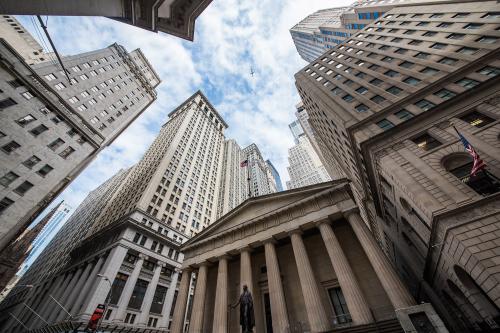The bipartisan Infrastructure Investment and Jobs Act “is a huge first step to tackle long-range challenges” like climate change, says Adie Tomer. The $1 trillion investment in water and power infrastructure, expanding broadband and rail, and changing how communities are developed will “give us a good chance to go into the laboratory to see what the future of the country might look like, and then continue to double down on that going forward.”
Related material:
- The Senate infrastructure bill puts America closer to another New Deal
- What regional leaders want from Biden’s infrastructure bill
Listen to Brookings podcasts here, on Apple or Google podcasts or on Spotify, send email feedback to [email protected], and follow us at @policypodcasts on Twitter.
Thanks to audio producer Gaston Reboredo, Chris McKenna, Fred Dews, and Marie Wilken for their support.
TRANSCRIPT
PITA: On Tuesday, the Senate passed the Infrastructure Investment and Jobs Act, an uncommonly bipartisan $1 trillion investment in the country’s physical infrastructure. With us to drill into what’s included in this bill and the future of additional infrastructure investment in this country is Adie Tomer, senior fellow with the Metropolitan Policy Program here at Brookings. Adie, thanks for talking to us again.
TOMER: Always great being with you, Adrianna.
PITA: So, this is a really enormous bill, it’s a negotiated compromise. You mentioned in a recent blog post that it’s trying to be all things to all people which of course it can’t be. So, let’s start with the good news. What are some of the big wins in this bill?
TOMER: Yeah, if we could do like a power ranking here, like big winners, like after election night, a big winner, Washington D.C., clearly can still pass bipartisan legislation, and not just the ones that don’t make front page news, but really matter, where it’s a little bit easier for politicians to, frankly, just negotiate in a calmer environment, this has been on the front pages, not just this whole calendar year but really for almost a decade now; us talking about needing something big. And this specific team of bipartisan senators – which, to remind folks right this isn’t Senator Capito’s negotiation with President Biden from earlier in the year; this is a whole different team after those negotiations fell apart. They delivered the goods. I mean we’ve got a massive new spending package. So, Washington’s ability to work is the huge winner here.
In terms of our optics, though the legacy on and in terms of the winning element is, as corny as it is to say it, it’s all about us and the communities we live in. I mean, that’s what infrastructure does, right? It builds a better future for everyone by helping make everything from business growth to seeing friends to having safe places to go do outdoor recreation, it makes all that possible. And this thing is really, really big. By our estimates, just this deal alone, including its reauthorization of current spending levels – so think about what we did in 2019 and 2020 already at the federal level – this is about as big as the New Deal was on infrastructure. That’s before we count reconciliation and before we count an innovation-focused bill that the Senate’s already passed. So there’s a lot of action happening in the infrastructure arena and we’re about to see generational investments.
PITA: One of these massive generational issues is, of course, climate change, and on Monday, the IPCC, the UN Intergovernmental Panel on Climate Change, released a stark report on the severity of the changes we’re already seeing in the world due to climate change and warning just how quickly humanity needs to start ratcheting back on carbon and other greenhouse gas emissions in order to avoid further devastating and irreversible damage. So, how does this bill address either President Biden’s own ambitious goals for cutting greenhouse gas emissions in half by 2030, and/or for building climate resilience into U.S. infrastructure?
TOMER: Yeah, the UN report is really tough. It wasn’t news to so many of us; I think we know how bad it is. The imagery is getting more visceral. You know, that that picture from Greece on the same day, with the forest fires, was just heartbreaking, to say nothing of what’s happening in California right now. You know, the subway’s flooding in New York just a month or two ago, and our long memories of Harvey and Katrina, so we’ve known this was a real big problem.
The federal government is not the major owner of infrastructure, or certainly real estate – that falls more to states and local governments – but what the federal government does that’s really, really important here is, they set the tone for the country. And, ideally, they can also use a mix of carrots and sticks to incentivize either more research and development or more resilient projects both for private actors as well as those other state and local governments. This bill does a ton to start shifting federal attention and programming towards more sustainable ends.
So, let me give you some examples. There’s $47 billion to make infrastructure more resilient. $55 billion in new, mostly drinking water-focused resilient investments. $65 billion in power infrastructure, mostly focused on our electrical grid and making sure it can handle the transition to more renewable power sources and how their electricity needs to be transmitted and distributed from generation sources to basically our homes and buildings where we work all throughout the country. They’re even focused on drought in the western states and communities with their water issues. So, there is a ton of resilient focus investment here.
It alone will not accomplish this job, but what I think we should think about is in two parts. Number one is the reconciliation bill that Senator Sanders has now kind of provided us a one-page framework, so you know, for, what is it three and a half trillion dollars bill to only have one page that seems a little. . .
PITA: That’s a lot of abbreviations.
TOMER: Right. So, once we find out that what’s in it, it’s clearly going to be a massive investment in potentially R&D, potentially clean energy tax credits, certainly we heard about a civilian climate corps, so we’ll get more kind of workforce-focused investments there. The point being, the federal government is not done with resilience, if you will, this calendar year. So, we’re going to learn a lot more in the coming weeks if not months.
Second is that these resilient investments will take time, so what I really want to stress to folks is this transition to actually basically recognizing climate change, not ignoring it. Again, a bipartisan group of senators voted to approve, many of them representing very red, if you will, Republican states, also many who questioned climate science right up until even a few years ago. That’s a huge change. And starting to execute these kinds of projects and investments, again, in resilient infrastructure design, water infrastructure, will give federal agencies some proof of concepts, some best practices and worst practices, and in five years from now, when this bill is effectively expiring, they can come back to the negotiating table and continue to invest.
It took us generations, many, I mean really back to the start of industrialization to get where we are now on climate change; it’s not going to be solved in five, if not probably even multiple decades of planning and investment.
PITA: Yeah that’s – it’s not a one-shot pill on that.
What were some of the major compromises in this bill? Where, like okay, it’s good we’re at least doing something, but where you might have liked to have seen more action or where folks may not be quite as pleased on some of the compromises that had to be stuck in order to get this passed at all?
TOMER: Yeah, there are a ton of compromises here. And there’s been some somewhat disingenuous reporting comparing this infrastructure bill to the American Jobs Plan. I want to remind folks the American jobs plan was like a budget, which, for those of us kind of have to live and work in Washington know the annual rite of passage of a president releases a budget — from both parties, right? I mean it’s a political document, so comparing it to that is a little unfair.
But even within the traditional infrastructure sectors we saw some real cuts. Many of us, me included, would’ve loved to see much bigger investment in public transportation. The $39 billion figure frankly got cut down by $10 billion from when, just a few weeks prior, President Biden and Senator Portman and others announced an agreement. So, it could have been more there. There weren’t controls so far that the House looked for on the highway investment side to make sure less money would go towards roadway expansions and a bigger focus on maintenance and even using more resilient materials. The electric vehicle investments went way down from the American Jobs Plan and there was initially some hope that the senators would have a lot more investment there. But those are really kind of the singular biggest cuts that were that were kind of announced that the Senate was thinking about and they just didn’t come through in the final package. But I want to stress, if you compare this in total, and, especially if you’re a progressive, frankly, on infrastructure issues and you compare this to the last great wave of infrastructure bills – just big ones from five years ago on surface transportation, two years ago on water – these are huge changes.
We haven’t even talked about broadband yet, but there really was no federal presence on broadband outside of some very targeted programs for the FCC. $65 billion in broadband is basically the first big federal investment in our history in broadband investments at scale. You know, those resilient investments we just talked about, I mean, we’re talking basically at the $200 billion investment level, many of those are brand new. So, it’s on digitalization and resilience — huge changes, big investments.
I would have liked to see more on a sustainable transportation front, but, look, if you take the whole package, that’s what compromise looks like in Washington; this is a good deal for the country.
PITA: Right, well, there was a lot of debate in the run-up to this bill about what counts is infrastructure, sort of dividing between hard and soft infrastructure. This bill is the more traditional elements — you have roads and utilities and trains and that kind of thing. And so, of course, the reconciliation bill that you mentioned, the $3.5 trillion budget bill including things like childcare and Medicare expansion and a lot of the additional climate change priorities and that’s you know, this is all being put to this separate bill. However, House Democrats have said that they they’re not going to vote on the infrastructure bill until this budget bill comes through the reconciliation process and comes to the House side as well. Does that give you any kind of concerns about the future of this, call it part one of this infrastructure bill?
TOMER: I know it should, but it doesn’t. And the reason I say that is, it’s really weird to see a bill like this. Again, as you pointed out really well, on traditional infrastructure sector, certainly kind of physical what we call your capital projects, but basically the physical stuff the stuff you can touch. That would be negotiated through, each chamber would have their own bill, they would go to what’s called the conference committee and they compromise again, and then they revote, and then that’s what would be signed by the president. That looks like it may not happen here. The House could try to extract a few concessions. I’ve some in mind that they might do, in particular – we talked about this on our piece that’s on the Brookings website – specifically earmarks, and again actually those restrictions maybe on highway spending to reduce new capacity. I could see those being added, but overall, this is a really good deal for House members and it’s going to mean that they’re gonna see projects in their communities. And you know nothing is better for a politician, especially one who’s already in office, than to cut a ribbon.
The reconciliation package picks up a lot of the other key priorities that both House Democrats as well Senate Democrats want to push over the finish line. Universal pre-K, workforce development programs, you mentioned many of these, right? Those are the other elements in the American Jobs Plan that weren’t in this bill. I believe that the total package is good enough that Speaker Pelosi, Steny Hoyer, they’ve got enough here to show their membership that, you know, if you compare where they’ll be, let’s say reconciliation and this infrastructure bill pass, that they can confidently go back to their constituents and say, when you voted me into office in 2020, in November, at this point now let’s say it’s November 2022, I have made your life better. And that’s the classic Washington retail politics line you use back in your district: is your life better now than it was before? And because of that, I think it builds confidence in me that both the reconciliation bill, because of course the numbers are there, as well as this infrastructure bill will get over the finish line, but it may be a reason to House Democrats don’t add any concessions, because they don’t want the Senate to revote. This is falling into line, though, that they can get both over the finish line at this point.
PITA: I want to wrap up with a big picture question. People who care about infrastructure are really excited because this is a massive and much-needed investment. This is larger than any other pot of funding in recent decades, but in a lot of ways it still doesn’t feel like enough because the U.S. has just fallen so far behind, not only on maintaining our existing infrastructure but just thinking about building ahead, and not to mention all the complexities of what needs to be done to meet the urgent challenge of climate change. How do you think about this bill, how should we think about this bill in that big picture of catching the U.S. up but also building ahead longer term, to get us to where our economy can sustain us longer-term?
TOMER: Yeah, an infrastructure bill like this really asks us to keep things in a long-term perspective. Infrastructure projects, as many folks know in their own communities, can take years, if not decades to get built. This is a five-year bill. It adds $550 billion in new spending. Adrianna, you and I are both old enough, if you will, not that old, but old enough to remember the stimulus act, which was almost that big for every category back in in ‘09, and this is all just mostly fixed capital projects in these infrastructure sectors. It is going to take all of the human resources we have at the federal, state, local levels, plus their private sector partners to do most of the construction and design here to actually spend all this money. And not just in five years. It’s going to take longer than that. So, this is a huge first step to tackle those long-range challenges.
And, as I mentioned earlier, I really hope folks feel good and think about where we were at this time last year. There were no major resilience programs inside the federal government; there was no big broadband package. And we haven’t even talked about $66 billion in railway investments, where, look it’s not going to build a lot of new high-speed rail lines, potentially none; it’s going to make things like the Northeast Corridor and the rail that connects Portland, Oregon and Seattle work a lot better. So, we’re going to see improvements to our infrastructure. We’re going to see ideally more resilient investments.
What’s going to be really important now is not only that we spend it well, but that in about five years’ time we don’t take our foot off the gas, proverbially, and we continue to invest, especially in resilience and digitalization going forward. This is going to be a long battle. I understand why advocates in certain specific infrastructure sectors could be disappointed if they were hoping for more, but this is not going to be our last bite at the apple. Hopefully states and local governments, who we work closely with, do really great things with this money and that creates awesome feedback loops with our federal leaders to say, hey, we can do more around resilient water investment, expanding broadband and digital skills training, actually building more high-speed rail and public transportation and changing how we develop our communities. This is going to give us a good chance to go into the laboratory to see what the future of the country might look like, and then continue to double down on that going forward.
PITA: Adie, I always leave our conversations feeling much more hopeful about where we are on infrastructure priorities and where we might yet get to be. So thank you again, as always, for talking to us and laying everything out in a hopeful and forward-looking fashion.
TOMER: Oh, thanks, Adrianna, always great talking with you too.





Commentary
PodcastHow does the Senate infrastructure bill invest in future resilience and growth?
August 11, 2021